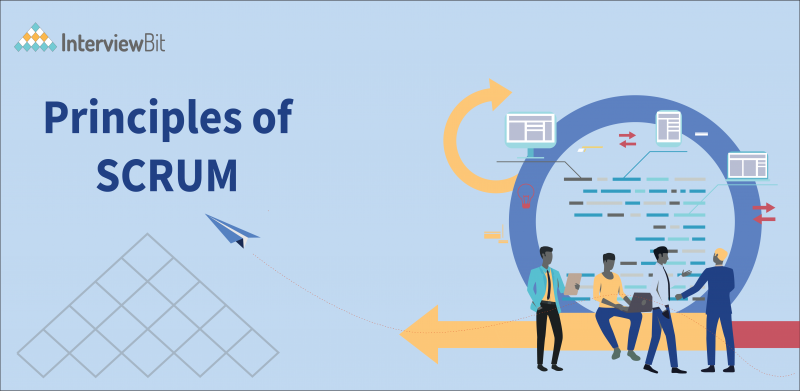- A Brief History of Scrum
- What is the Scrum Process?
- Explain the Three Scrum Roles
- Scrum Artifacts
- 5 Scrum Values
- 6 Principles of Scrum
- 1. Empirical Process Control
- 2. Self-Organization
- 3. Collaboration
- 4. Value-based Prioritization
- 5. Time-Boxing
- 6. Iterative Development
- Benefits of Scrum Methodology
- Conclusion
- FAQs
- Q.1: What are the 4 Scrum values?
- Q.2: What are the four key practices of Scrum?
- Q.3: What are Scrum techniques?
- Additional Resources
Ịn project management, Scrum is a popular term. You’ll often come across people talking about time-boxing, iterations value-based prioritisation, but what do you know what actually means? Scrum is utilised in the development of software, based on iterative and incremental processes.
Scrum is a versatile, speedy, flexible, and efficient agile framework that is devised to provide value to the customer, and stakeholders throughout the evolution of the project. The development begins from a general view of what must be built, elaborating a list of elements ordered by priority (product backlog) that the owner of the product seeks to acquire. Scrum is best comprehended through practical application: the more you use it, the more you’ll understand it and can refine it to fulfil the requirements of your team. Hence in this article, we’ll describe the principles and values of Scrum, its benefits, and how you can utilise them in your day-to-day work.
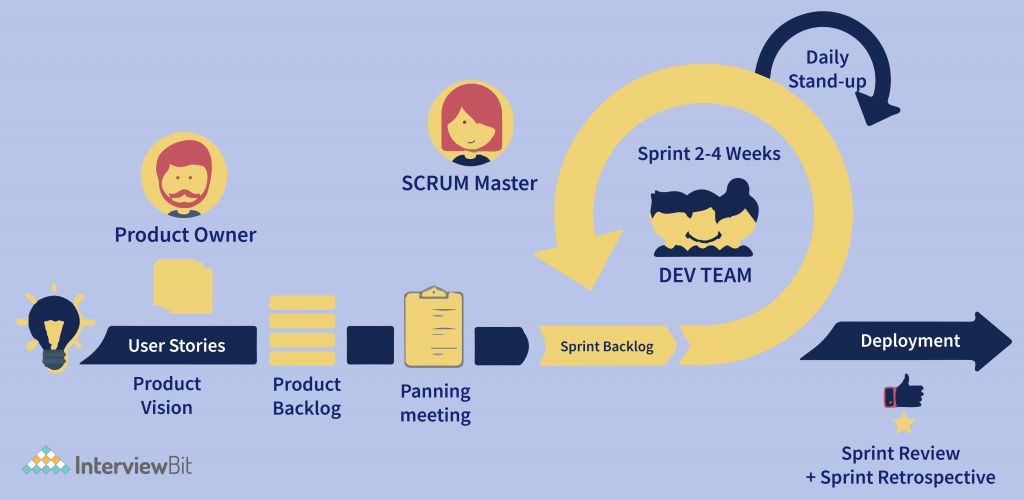
A Brief History of Scrum
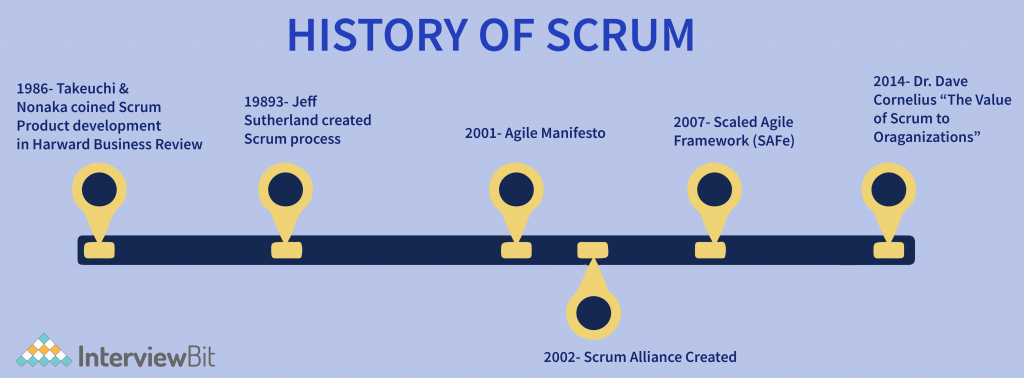
In the fast-paced, overly competitive world of commercial new product development, flexibility and speed are important. Organisations are increasingly admitting that the old, sequential strategy of creating new products will simply not get the job done. The history of Scrum goes back to the year 1986 in the Harvard Business Review (HBR) article named, “The New Product Development Game” written by Ikujiro Nonaka and Hirotaka Takeuchi. This article explains how organisations like Fuji-Xerox, Honda, and Canon make new products worldwide with the help of a team-based and scalable strategy for product development. This strategy highlights the significance of empowering self-organised teams.
Confused about your next job?
The article cast an impact to create many of the ideas that marked the birth of what we now call Scrum. For over two decades, Scrum’s been around and is assisting many people in successfully creating new products speedily and more effectively. Officially, in 1995 this framework was first presented to the public by Ken Schwaber and Jeff Sutherland.
The formal Scrum model was the outcome of numerous years of learning and experiments. The scrum process was built to be utilised in the process of software development by incorporating the concepts of the 1986 article as well as the notions of empirical process control, iterative development, incremental, object-oriented development, software processes, and productivity improvement, along with the development of complicated and dynamic systems.
The Scrum framework effectively contests the old way of thinking. With Scrum, there’s a chance that the results are different than expected, which needs a fair share of integrity to retain transparency, admit failure, and make decisions around it. There was a necessity for a system that would be more trustworthy and responsive to modifications.
What is the Scrum Process?
The Scrum process facilitates one to operate with what they have and constantly assess what is or is not functioning. Good communication is important and is carried out via meetings, called “events.”
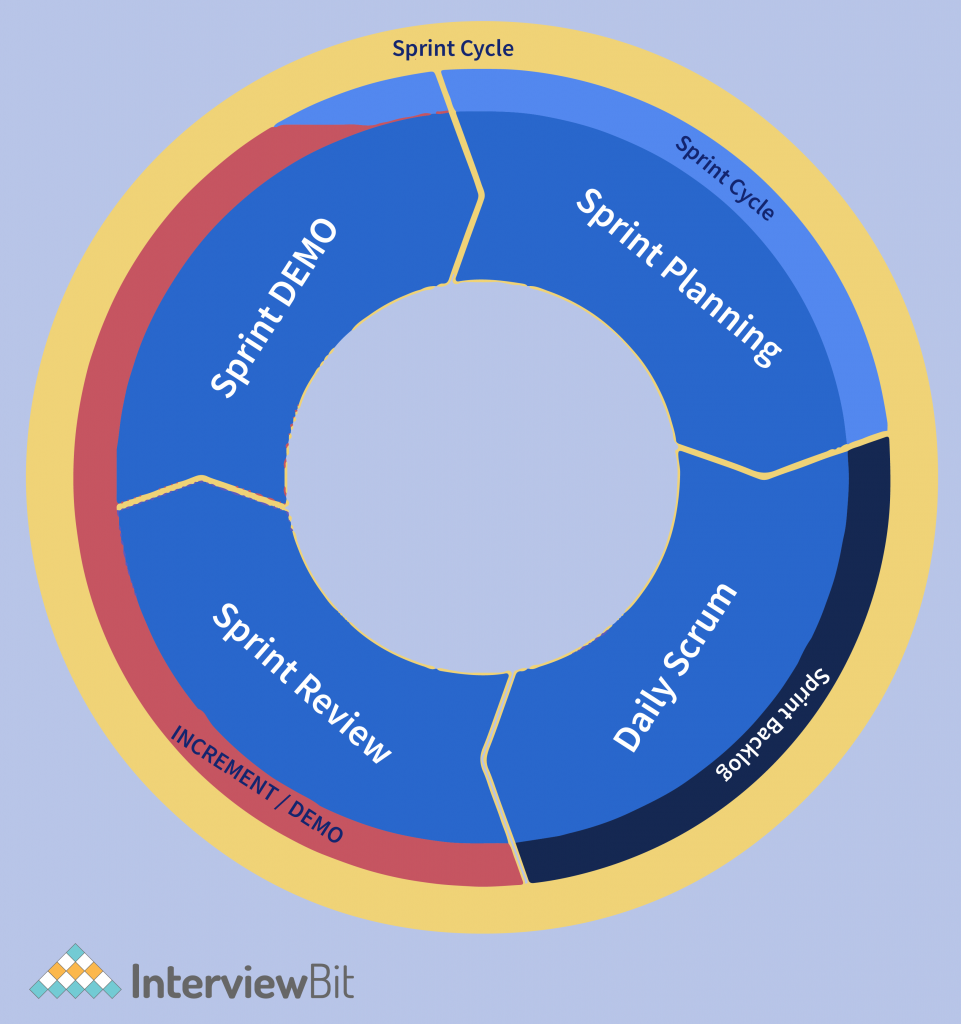
Scrum events incorporate the following:
- Daily Scrum. This event is a short, stand-up daily meeting that is carried out in the exact place and time every day. In these meetings, the team assesses the work completed the previous day and chalks out what will be accomplished in the next 24 hours. During this time, the team members discuss the impediment.
- Sprint. This refers to a short span of time wherein a development team functions to accomplish certain deliverables, tasks, or milestones. Also called “iterations,” Sprint essentially splits the project schedule into digestible blocks of time wherein smaller goals can be achieved.
- Sprint Planning Meeting. In this meeting, the team, including the Scrum Product Manager, Scrum Team, and Scrum Master meets to decide which backlog items will be addressed in the upcoming sprint. This is a collaborative process that lets team members have a say in when work happens.
- Sprint Review. This happens at the end of the sprint and is devised to garner actionable feedback on what the Team has achieved. It is also regarded as the “Demo” and is an amazing chance for the team to display its work and review the overall roadmap for the product
- Sprint Retrospective. This meeting takes place after a Sprint ends. During this meeting, everybody contemplates the process, a team-building exercise is offered, team talks about what it should continue to do, stop doing, and start doing. An essential purpose of this event is continuous improvement.
Explain the Three Scrum Roles
A Scrum team comprises three specific positions: one Scrum master, one product owner, and several development team members. Let’s inspect what the duties are for each of these roles.
1. Scrum master
A Scrum master makes sure a Scrum team is working as productively as possible with Scrum values. This implies that the team is kept on track, plan and conduct meetings, and seek solutions to any obstacles the team might encounter. Scrum masters might also function in a broader role within a company to help it incorporate Scrum approaches into their work. As they are both behind-the-scenes supporter, and a leader,we generally call them as the “servant leader” of the Scrum team. A Scrum master might have the following responsibilities:
- Promote regular Scrum meetings (also hailed “daily standups”)
- Head sprint planning meetings
- Plan “retrospective” reviews to check what went smoothly and what can be improved for the following sprint
- Pulse on every team member should be kept via individual meetings or other modes of communication
- Deal with hardships that set in for the team by interacting with stakeholders outside of the team
2. Product owner
A product owner ensures the Scrum team is aligned with the goals of the product that the team is committing to. They figure out the business requirements of the product, such as market trends and customer expectations. Since they have to comprehend how the Scrum team fits into bigger picture goals, product owners generally keep in touch with the stakeholders outside the team and product managers. Following are the duties of the Product Owners.
- Deal with the product backlog by assigning work with priority
- Establish the product vision for the team
- Interact with external stakeholders and translate their requirement to the team
- Make sure the team concentrates on hitting product needs via communication and assessing progress
3. Development team
A development team comprises the professionals who perform the hands-on work of accomplishing the tasks in a Scrum sprint. This implies development team members can include writers, designers, computer engineers, analysts, or any other position required to reach sprint goals. The development team usually colludes to plan goals and plans for obtaining them and doesn’t simply wait for orders. Not all the members of the development team have the same duties. The duties of a development team depend on the end objectives of the Scrum team. Broadly speaking, however, you might find that someone can task a development team with:
- Assist in goal setting and sprint planning
- Lend prowess to program, design, or enhance products
- Use data to identify best practices for development
- Test products and prototypes, along with other types of quality assurance
Scrum Artifacts
Scrum Artifacts are devised to ensure the clarity of key information in decision making.
Product Backlog (PB): This is a list of enhancements, new features, tasks, bug fixes, or work requirements needed to make a product. It’s assembled from input sources such as market demands, general business analysis, customer support, and competitor analysis. The product backlog is updated on-demand as new data becomes available and is curated and maintained by the product owner between sprint cycles and as further ideas arise. It also contains tasks that were previously in an active sprint but deprioritized and shifted to the backlog.
Sprint Backlog (SB): It is a set of product backlog tasks that have been promoted to be created during the upcoming product increment. Sprint backlogs are made by the development teams to schedule deliverables for future increments and detail the work needed to make the increment.
Sprint backlogs are formed by choosing a task from the product backlog and splitting that task into smaller, actionable sprint items. It is updated while the sprint planning phase of the scrum takes place. The smaller sprint tasks are allocated to the relevant teams such as development and design.
Increment: A product increment is the client deliverables that were created by product backlog tasks during a sprint. It also contains the increments of all earlier sprints. There is always one increment for every sprint and an increment is determined while the scrum planning phase is on. An increment occurs whether the team chooses to release to the customer. Product increments are very helpful and complementary to CI/CD in version tracking and, if required, version rollback.
5 Scrum Values
If you manage a Scrum team, you already understand Scrum is one of the most efficient project management frameworks used today. Though popular, teams can only grasp the full advantages of the Scrum methodology by learning and enforcing the five Scrum values.
Quite similar to the values of an organisation, Scrum values are upheld by Scrum team members. These values are the basis on which the Scrum framework is created. Each team member must aim to uphold these values in the Scrum team charter, for the projects to attain their full potential. You can go through the article to understand what exactly are the five Scrum principles and values, why they’re so important, how you can elevate these values within your team, and start reaping the full advantages of this powerful project management methodology.
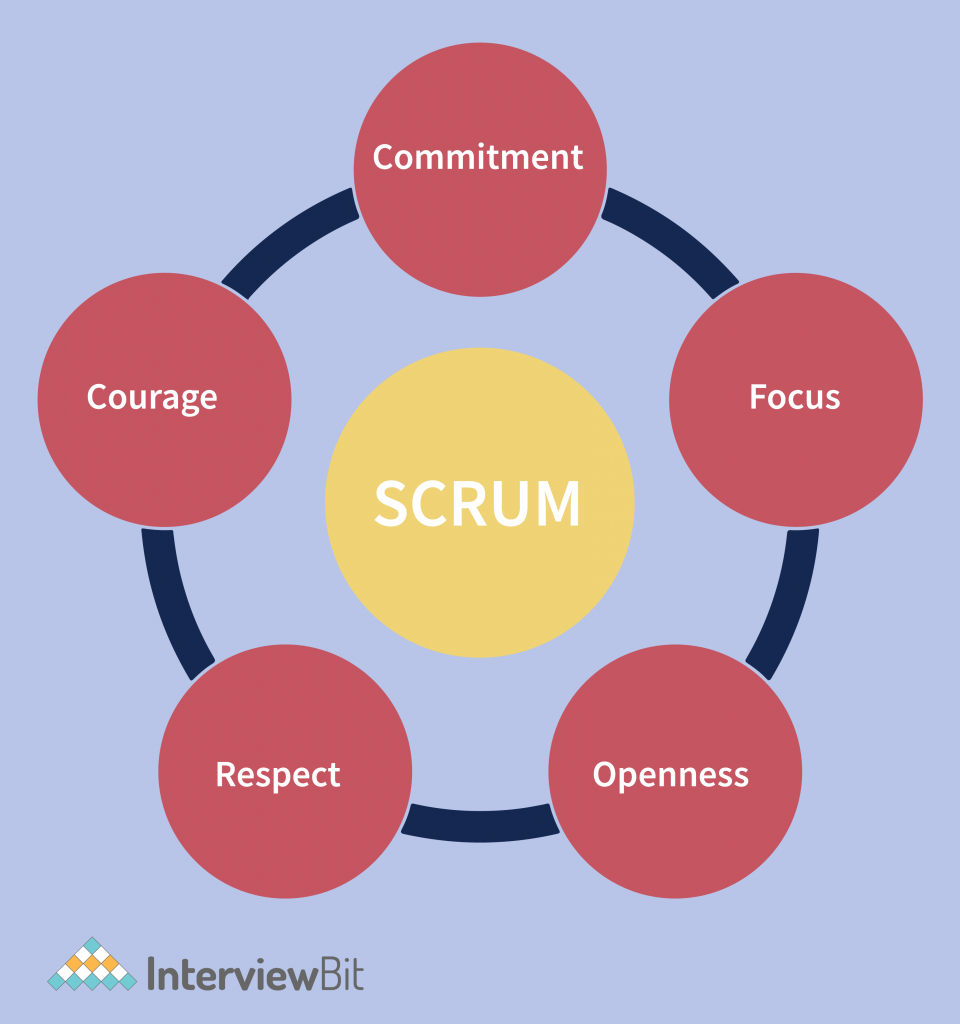
- Commitment: It is the expectation and dedication of the scrum team members to attain success, execute, and stick to the practical objectives and goals defined in the initial sprint meeting. The scrum team members have the liberty to split the hefty portions of work into smaller chunks to succeed step by step.
- Focus: The objectives of scrum deployment are transparent and pragmatic. As the bigger work is split into smaller tasks or sprits, the emphasis is on a few things at a time and causes no distraction or pressure of work. The priority is the specified objective of the sprint, and so is the dedication to achieve.
- Openness/Transparency: Scrum agile methodology facilitates clarity in the project management process. All the team members very well know about the progress of the project and the completed work as there is a scrum meeting held each day during the sprint execution. Transparency evades confusion and ambiguity amongst the cross-functional team members functioning on the project.
- Respect: Each team member has their strengths and is appointed to work on the project based on their strengths and qualities, and they must have mutual respect. The key to the success of Scrum is respect, which is fundamentally moral. Mutual respect among the scrum team members creates harmony. Therefore, respecting every person is the golden rule for agile project management to succeed.
- Courage: Scrum is all about embracing changes over time. Scrum facilitates the corroboration of conventional agile scrum practices along with contemporary technology to improve productivity and to improve the quality of the product created. It fosters safety and clarity in the process. Courage is about being prepared to embrace new agile practices. It takes courage to adapt to the Scrum agile method changes since at certain times the changes can be difficult, and decision making turns into a challenging task. A lot of courage is needed to implement changes to bring out improvement in the current system, it also requires courage to speak up when things are going wrong, when the feature is not in line with the product vision.
6 Principles of Scrum
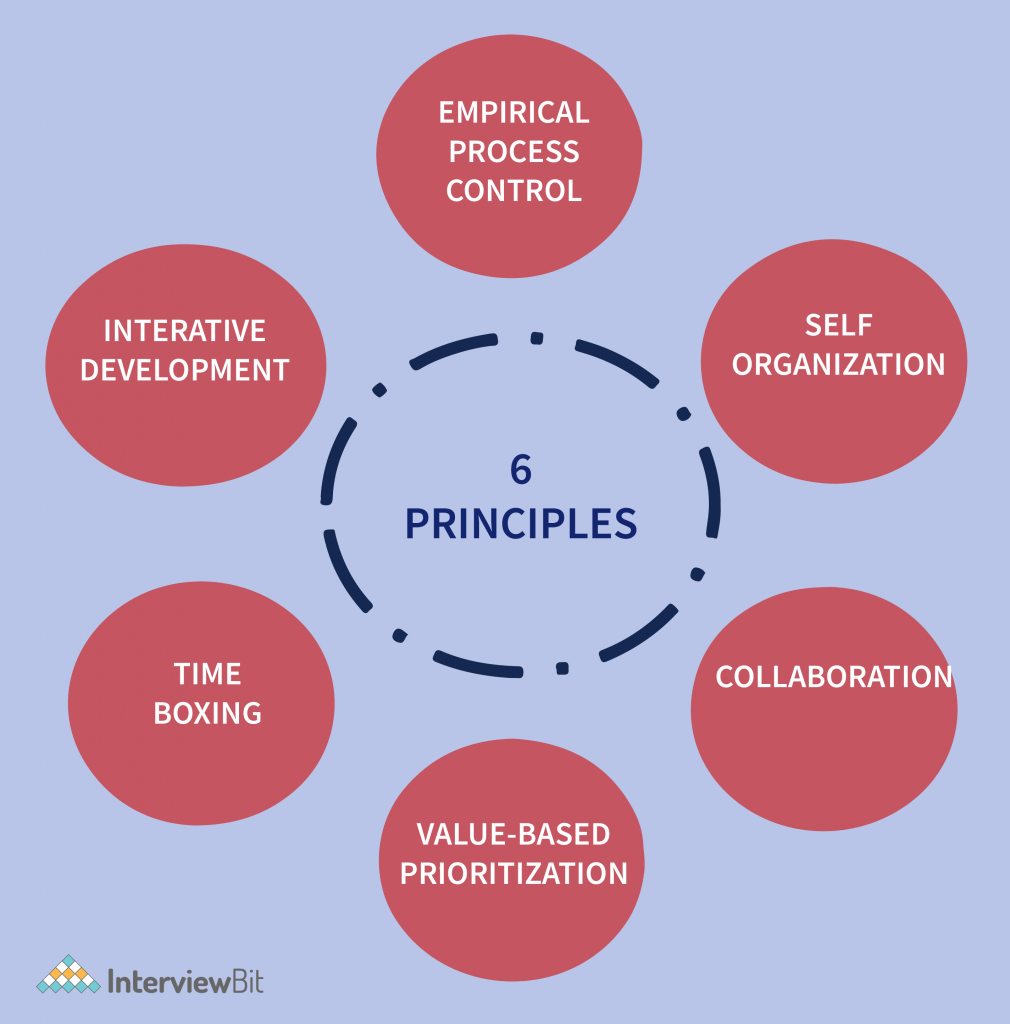
Scrum principles form the base of the underlying foundation for the scrum agile framework. The scrum principles, when implemented with the agile core values, enable one to enhance clarity and adaptation in project management. Scrum values and principles are the guidelines that are followed to support and structure the Scrum framework. It is a very popular and commonly incorporated methodology utilized for agile product development. Scrum mostly works on the association, functioning software, and flexibility to embrace the rising project or organization needs. Scrum is an agile method or framework for enforcing the agile software development life cycle. Scrum believes in team anticipation and collaboration of the cross-functional teams working in project management. Let us take a look at the principles of Scrum.
1. Empirical Process Control
The three pillars of Scrum that advocate every incorporation of empirical process control are inspection, transparency, and adaptation These three pillars are the fundamentals of Scrum and are talked about in detail below.
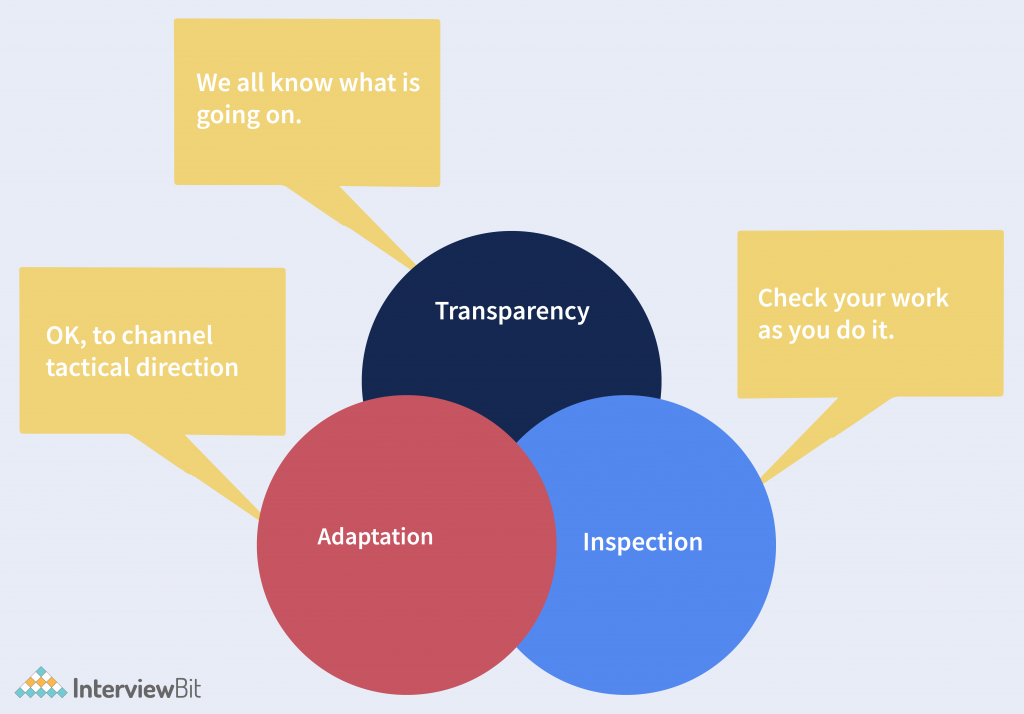
- Transparency: To take decisions, people require visibility into the process and the present condition of the product. To guarantee everyone comprehends what they are noticing, participants in an empirical process should share one language.
- Sprint Reviews Provide Transparency: Scrum’s regular reviews provide stakeholders and team members a transparent picture of the state of the project. Inspection control deviation from the preferred process or end product, people ought to inspect what is being made, and how, at frequent intervals. Inspection should take place at the point of work but it should not come in the way of that work.
- Sprint Reviews and Retrospectives Provide Inspection Opportunities. Scrum teams review their finished work and their process at the end of each iteration during the sprint retrospectives and sprint reviews.
- Adaptation: Adaptation suggests that when deviations happen, the product or process should be changed at the earliest. Scrum teams can adjust the product at the end of each sprint. Scrum permits adjustments at the end of each iteration.
2. Self-Organization
Conventional project management strategies make the manager assigns tasks to each one, and when they complete those tasks, they get assigned more. The Scrum framework considers every employee to be an adult. They’re not just competent in managing themselves, but almost always deliver better work that way. The word “assign” does not arise in the Agile Manifesto or any of the founding Scrum documents. During the daily scrum meeting, team members discuss among themselves. They name each product backlog item that ought to get accomplished and figure out how it’ll happen.
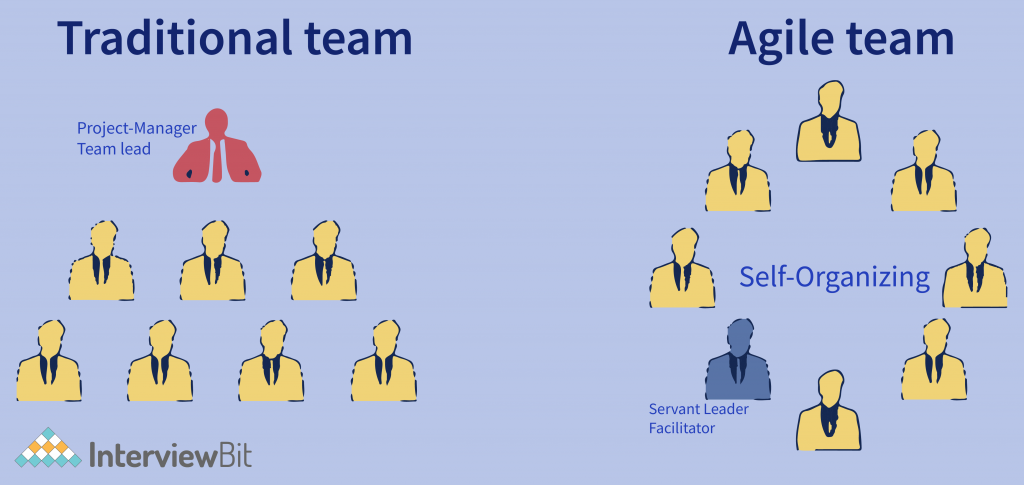
“Servant leadership” is the best leadership style in Scrum, which highlights attaining results by focusing on the requirements of the Scrum Team. Hence, a self-organizing team has the freedom to take decisions and they are cognizant enough to take ownership of their work. Thus, the team is likely to evolve as more self-motivated and strive to accept greater responsibility. Hence, when employees are self-organized, they provide much greater value. A few of the benefits of Self-organization are mentioned below:
- Shared ownership and Team buy-in.
- Motivation leads to an improved performance level of the team
- An innovative and creative environment facilitative to growth
Building a Self-Organizing Team in 3 Steps
To build a self-organizing team, the company should guarantee that it offers adequate training, the required infrastructure, and an incentive system to keep employees inspired at work. Designing a self-organizing team can be regarded as a three-step process.
- Training: Appropriate training can assist in satisfying many of the principles that self-organizing teams need. Especially, hard skills training can assure competency and deliver the essential framework to take tests that lead to continuous improvements. In the meantime, soft skills training can assist in laying the groundwork for high levels of collaboration, communication, confidence, and commitment.
- Coaching: Before evolving as a true self-organizing team, groups require coaching. They may need more guidance and support at the initial stage. This indicates that your team is getting more mature such as the team enjoys the work and members support each other, Scrum ceremonies are productive, teams are pulling work for themselves and new ideas are impending. Eventually, the function of the coach should subside over time as team members understand how to take ownership and start to cooperate with and trust one another in a self-organizing way.
- Mentoring: Once a team starts practising self-organizing, the journey has only just started. Allot mentors who can support the team, so that it goes to the next level and the growth of the team will be sustained in the longer run. For instance, job rotations can be an essential element of keeping employees involved and of fostering continuous learning, as this type of mentoring could help with continuity by assuring everyone succeeds together and stays motivated.
3. Collaboration
Open communication between the Scrum Master, the Scrum Team, and the Product Owner, on a day-to-day basis, is a very significant element of Scrum-Agile implementation. Continuous engagement through daily meetings enables us to confirm requirements, provide results and validate them faster. Furthermore, as every person is well aware of one another’s work, they add more value to the everyday meetings by proposing how deliverables have to be reintegrated so that the software product is viable. When everybody engaged in the process of the software development process has a say, the most promising ideas are brought forth get enforced as per the priority set for them. The primary guidelines of collaborative work are:
- Awareness — People working together ought to be cognizant of each other’s work.
- Articulation — Cooperating individuals should partition work into units, split the units among team members, and post the completion of work, reintegrate it.
- Appropriation — Embracing technology to one’s own situation; the technology may be used in a way quite different than anticipated by the designers.

Collaborating in such a way also helps to use technologies and tools in distinct way as long as it works for the team. Thus, collaboration is one of the very crucial factors of applying the Scrum framework to obtain the best results without wasting time on things that are not necessary at the present stage.
A few of the advantages of Collaboration are:
- Minimization of change requests
- Risk Mitigation
- Growth in efficiency
- Continuous improvement
4. Value-based Prioritization
Value-based prioritization is one of the important principles of Scrum. What it implies is that the Scrum team doesn’t choose a task erratically, but clearly explains which tasks need attention, which tasks should be accomplished now, and which ones need to be executed later. Thus, the Scrum approach enables continuous and quicker delivery of a product or service to clients. This in turn also enables us to identify of what modifications to be implemented to make the product even more viable and fulfill the requirements of the clients with the purpose of delivering the maximum business value in a short span of time. So, value-based prioritization significantly helps enhance user experience (UX), which too much faster than typical in the software development process.
Mentioned below are the three elements to consider while prioritizing tasks:
- Value
- Risk or uncertainty
- Dependencies
5. Time-Boxing
Under the Scrum framework, all tasks are timeboxed, which suggests assigning a specific amount of time to finish each process and task. A span of two weeks is generally allotted to execute a sprint. Releasing in short intervals enables one to look for and resolve issues in the early development cycle instead of reinventing the wheel after working on numerous modules for months and releasing them in one go, only to discover that the changing market demands by the time product development is completed. Time-boxing also helps iterative development so that any modifications that need to be implemented can be accomplished in the next sprints.
Mentioned below is a “time box” of the 5 events corresponding to a 1-week Sprint in Scrum
- Sprint: Timeboxing is utilized to define the Sprint’s length. The Sprint is a timebox of one week in which the scrum team will provide the Sprint goals
- Sprint Planning: The timebox should not surpass 2 hours / Sprint length is 1 week.
- Daily Scrum: The timebox should not surpass 15 minutes.
- Sprint Review: The timebox should not extend more than 1 hour / Sprint length for 1 week.
- Sprint Retrospective: The timebox should not extend more than / Sprint length for 1 week.
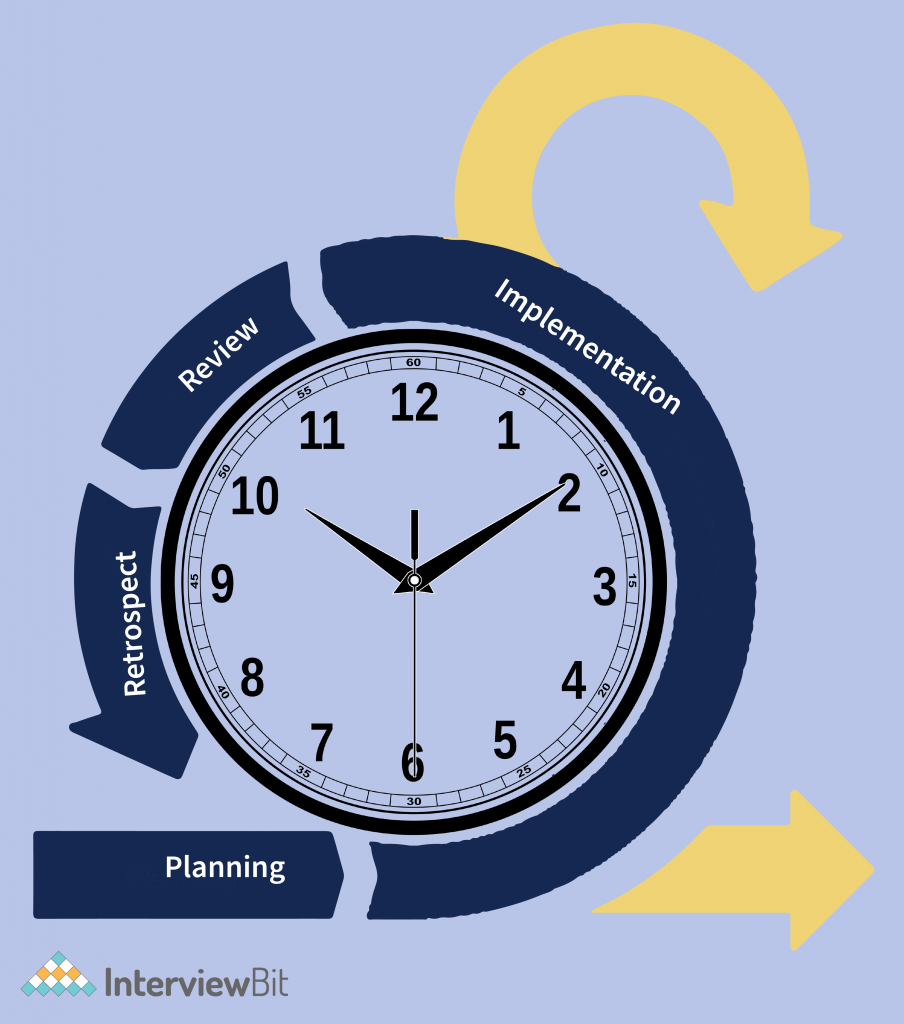
The Benefits of Timebox
- Priority: Priority is needed for all issues that arise during the time.
- Focus: Focus should be on the “most crucial” things under time constraints.
- Stop Loss: Things should have a stop loss point guided by the principle of time.
- Rhythm: The time limit should create a certain sense of rhythm.
6. Iterative Development
For many software projects, it’s not feasible to describe what each requirement related to the end product may look like even before a single line of code is composed. This is where Scrum comes into the picture in creating a product viable by letting to implement changes as and when the need emerges. In the software development process, keeping an iterative model not just significantly decreases the time to reach the endpoint, but also empowers you to provide what precisely the current breed of clients seeks from your service or product. The scrum-agile environment allows splitting down complicated tasks into different, small sprints and implements learning in an iterative manner to deliver what has to be delivered faster.
Let’s look at some of the benefits of Iterative Development are:
- It permits course correction since all the people involved have a better knowledge of what ought to be delivered as part of the project and incorporate this learning in an iterative manner.
- The time and effort needed to get to the final endpoint are significantly decreased and the team delivers deliverables that are best suited to the final business environment.
The above-mentioned six principles form the core basis for how to move about utilizing Scrum to let your software project deliver the best outcome. Pursuing those principles can assist you to build an environment where everybody feels a part of it and takes ownership to provide a quality product in a timely manner.
Benefits of Scrum Methodology
Scrum has many benefits as compared to other agile development methodologies. Currently, it is the most trusted and used framework of reference in the software industry. Below are some of the common advantages of Scrum:
- Easily Scalable: Scrum processes are iterative and are managed within certain work periods, making it more effortless for the team to concentrate on specific functionalities for each period. This not only has the benefit of accomplishing better deliverables in line with the requirements of the client but also provides the capability to the teams to scale the modules in terms of scope, design, functionality, and characteristics in an orderly, clear, and straightforward manner.
- Compliance of expectations: The client sets their expectations demonstrating the value that every requirement or history of the project brings, the team evaluates them and with this data, the Product Owner designates its priority. Regularly, in the sprint demos, the Product Owner ascertains that the needs have been fulfilled and communicates feedback to the team.
- Flexible to changes: Swift reaction to modifications in requirements caused by client demands or market developments. The methodology is developed to adjust to the changing needs that complicated projects entail.
- Time to Market Reduction: The client can use the project’s most essential functionalities before the product is fully ready.
- Higher software quality: The working method and the need to acquire a functional version after every iteration, allows to obtain higher quality software.
- Timely Prediction: With the help of this methodology, we will learn about the average speed of the team by a sprint (story points), with which, consequently, it is feasible to assess when a specific functionality, that is still in the backlog, is going to be available.
- Reduction of risks: The idea of executing the most valuable functionalities in the first place and understanding the speed with which the team makes advancements in the project, lets one evade risks effectively in advance.
Conclusion
Scrum constitutes of short “sprint” methods to accomplish a prosperous project or product development and its implementation. Scrum methodology is applied to projects which comprise around 10 team members and is conducted as per short cycles with daily scrum meetings, which are managed and conducted by a Scrum master working within the agile framework.
In software development projects, the Scrum methodology is the most widely applied. Furthermore, the Scrum framework is applicable to other business changes which are open to real-time changes. Scrum development starts with the primary sprint planning, where the agile team members determine the needs and tasks they can devote to and then devise a sprint backlog, which is an exhaustive list of the tasks to be accomplished during the sprint execution.
The scrum framework as a whole is easy, the rules, roles, artefacts, and events are simple to comprehend. Its semi-prescriptive method actually allows to pull out the ambiguities in the development process, at the same time offering adequate space for businesses to bring forth their individual flavour to it. Scrum’s success in creating complicated software and hardware products across myriad industries and verticals makes it a convincing framework to embrace for your organization.
FAQs
Q.1: What are the 4 Scrum values?
Ans: The four scrum values are courage, commitment, Focus, and openness.
Q.2: What are the four key practices of Scrum?
Answer: The key practices of Scrum are
- Product Backlog and Prioritization
- Sprint Plan and Requirement Refinement
- Start Sprint and Stand-Ups
- Burndown Chart
Q.3: What are Scrum techniques?
Ans: Scrum techniques are the tactics, tools, and techniques, embraced by Scrum Masters. Scrum masters are liable for setting an efficient Scrum environment where team members comprehend the theory and methodology and provide work of the highest quality.


